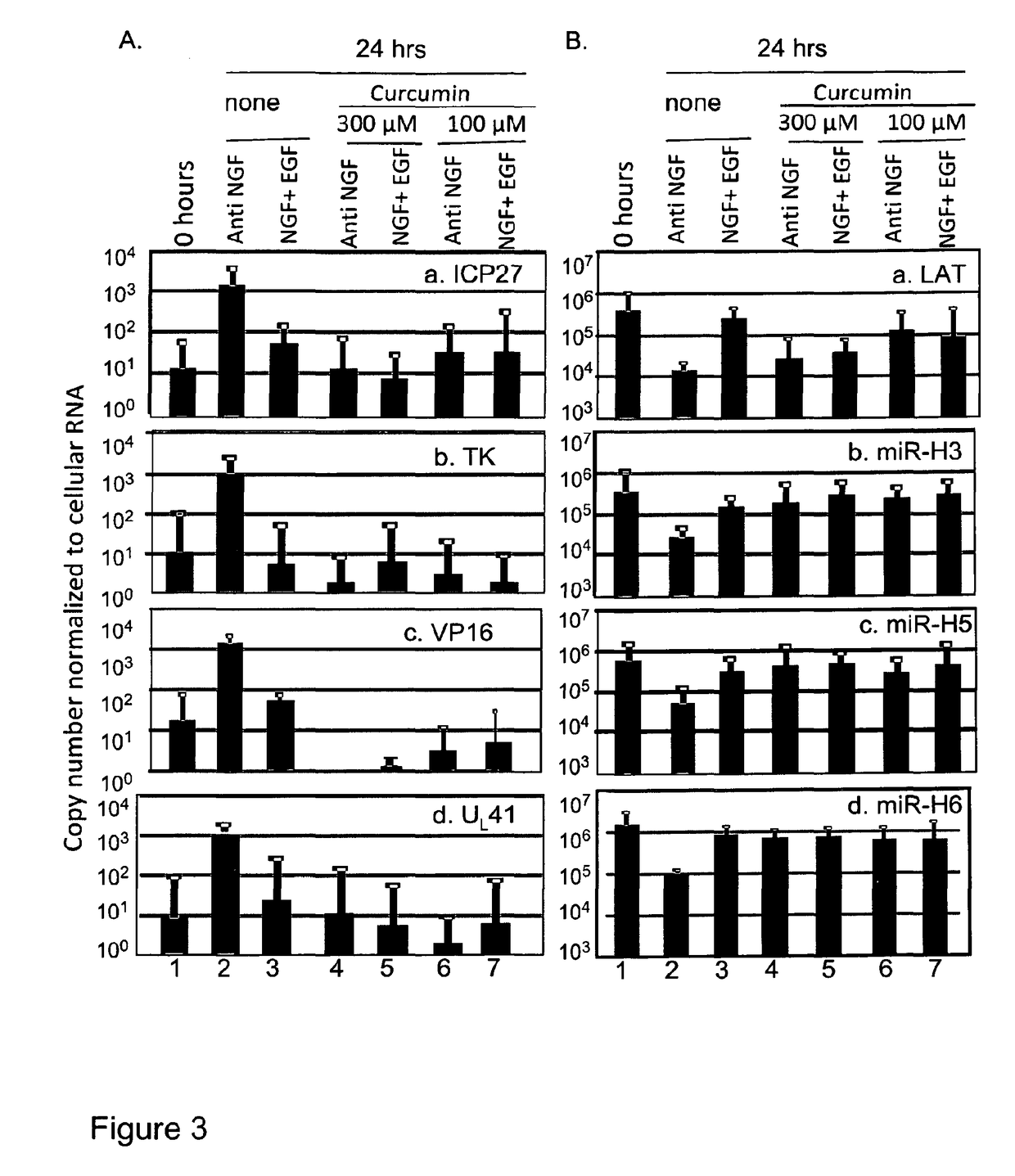Modulation of reactivation of a latent virus
a technology of latent virus and module, which is applied in the field of module of can solve the problems of hsv-2 genital infection that antiviral drugs have no effect on latent virus, reactivation frequency or shedding, etc., and achieve the effect of promoting or inhibiting the reactivation of latent virus in an individual and promoting reactivation of virus
- Summary
- Abstract
- Description
- Claims
- Application Information
AI Technical Summary
Problems solved by technology
Method used
Image
Examples
example 1
HDAC Inhibitors Activate Latent Virus in the Ganglionic Organ Culture Model
[0057]Earlier studies have shown that HSV-1 can be reactivated from latently infected neurons by HDAC inhibitors [Robert et al., J Neurovirol. 11: 306-317 (2006)]. These studies verified that HDAC inhibitors, both broad spectrum and those with some degree of specificity, reactivated HSV-1 in latently infected trigeminal ganglia maintained in organ culture incubated in medium containing NGF+EGF. In this series of experiments three inhibitors were tested. Trichostatin A (TSA) is a broad spectrum HDAC inhibitor [Robert et al., J Neurovirol. 11: 306-317 (2006); Kazantsev et al., Nat Rev Drug Discov 7: 854-68 (2008)]. Earlier studies showed that it induces the reactivation of latent virus in neurons harboring latent virus [Robert et al., J Neurovirol. 11: 306-317 (2006)]. MS275 and MC1568 at low concentrations act as specific inhibitors of HDAC 1 and 4, respectively [Nebbioso et al., EMBO Rep 10: 776-82 (2009); Kh...
example 2
The Construction and Testing of Recombinant HSV-1 Expressing a Wild-Type and Dominant-Negative STAT3
[0064]This series of experiments verified that disruption of STAT3 function induces reactivation of latent virus, which was revealed by using viruses that deliver a wild-type or a dominant-negative STAT3(dnSTAT3) to the infected neurons.
[0065]The procedures for construction of the recombinant viruses are as follows.
Virus Strains and Cells
[0066]Vero cells originally obtained from the American Type Culture Collection were grown in Dulbecco's modified Eagle's medium supplemented with 5% fetal bovine serum. The BAC encoding the HSV-1(F) DNA was reported elsewhere [Zhou et al., Proc Natl Acad Sci USA 110: E498-506 (2013)].
Plasmid Construction STAT3, dnSTAT3
[0067]The plasmid (pMXs-STAT3) containing wild-type STAT3 is described in Takahashi et al., Cell 126: 663-76 (2006). The mutant STAT3 with a single substitution of Y705F (dnSTAT3) was obtained by usage of the QuikChange XL Site-Directed ...
PUM
| Property | Measurement | Unit |
|---|---|---|
| concentrations | aaaaa | aaaaa |
| time | aaaaa | aaaaa |
| volume | aaaaa | aaaaa |
Abstract
Description
Claims
Application Information
 Login to View More
Login to View More - R&D
- Intellectual Property
- Life Sciences
- Materials
- Tech Scout
- Unparalleled Data Quality
- Higher Quality Content
- 60% Fewer Hallucinations
Browse by: Latest US Patents, China's latest patents, Technical Efficacy Thesaurus, Application Domain, Technology Topic, Popular Technical Reports.
© 2025 PatSnap. All rights reserved.Legal|Privacy policy|Modern Slavery Act Transparency Statement|Sitemap|About US| Contact US: help@patsnap.com



